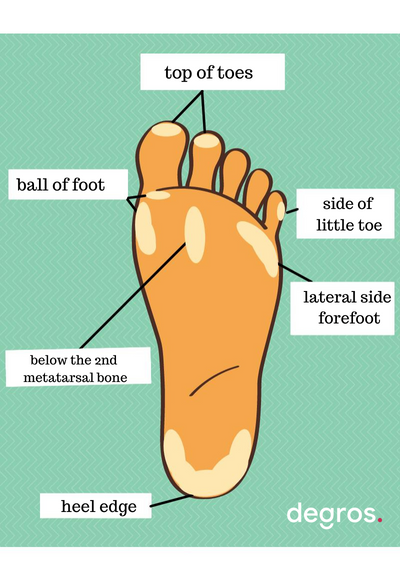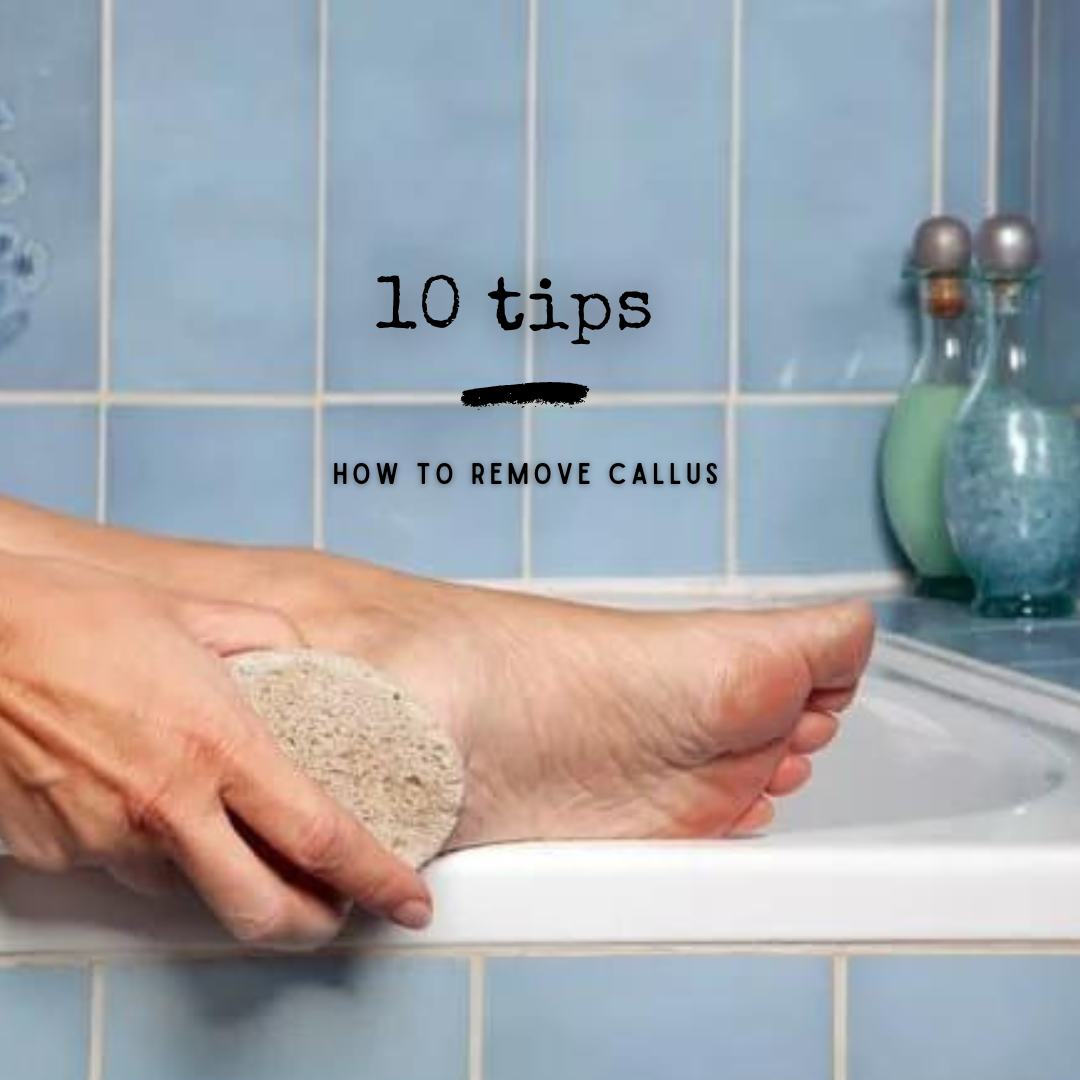Remove calluses; 10 tips to make and keep your feet free of callus!
Calluses; a common foot problem.
Table of Contents
What is calluses?
Callus is a natural protective layer of the skin that everyone has to a greater or lesser extent. It is a yellow, white or transparent thickening of the epidermis (the horny layer), which serves to protect the skin on the hands and feet. Young children have virtually no calluses, but as we get older, the epidermis thickens in places that are exposed to a lot of pressure and friction. As long as the callus layer is evenly distributed and does not irritate the underlying skin, we speak of physiological calluses. This is a normal and useful protection of the skin and does not need to be treated.
Persistant Calluses
In some cases, the callus continues to thicken under the influence of pressure in certain places and pain or a burning sensation may arise. Calluses are one of the most common foot problems. Callus does not only occur on the soles of the feet, it can also cause problems on the front, side, between the toes and on the hands. Calluses form faster on dry skin and genetic predisposition also plays a role. On the feet, calluses often appear on the heel edge, on the top of the toes, on the side and bottom of the big toe, and under the ball of the foot. Cracked heels can arise and if the callus grows inward, you get you suffer from corns. In this blog we will not discuss the treatment of cracked heels and corns, as this requires a specific approach.
What can you do if you suffer from excess calluses?
Do you suffer from calluses on your feet or do you just not like the thick yellow layer of skin? Then you want to do something about it. Do you work with your feet yourself or do you prefer to seek professional help. Read our tips below on how to get rid of excess calluses and how to prevent it from building up again quickly.
Have a look at our Callus-remove-action-package. This gives you everything you need to remove your calluses yourself and prevent the build-up of new calluses.
With the following tips we will help you remove excess callus and prevent it from coming back.
5 tips to remove calluses
-
Tip 1 > Visit a (medical) pedicure
Perhaps a no-brainer, but with recurrent pain complaints and for people with diabetes or rheumatism, visiting a professional is not an unnecessary luxury. It is also very pleasant for people without a medical indication, because taking care of your own feet requires a lot of flexibility. A (medical) pedicure works hygienically (nitrile gloves) and will cut and/or mill away the callus with the right instruments. This is a painless treatment because calluses are numb skin and the milling machine is often cooled with water. -
Tip 2 > First soften the callus before removing it
Do you want to remove your calluses yourself? Soften the calluses first by taking a foot bath (possibly with baking soda) or by applying a callus softener. This makes the skin easier to remove with a pumice stone, file or grater. Just make sure the skin is dry again when you start.
-
Tip 3 > Use the right tools
A pedicurist uses a scalpel blade to remove thicker layers of callus. We do not recommend doing this yourself! You need a practiced, steady hand for this and you can seriously injure yourself if things go wrong. With a pumice stone, callus slicer, grater or foot file, you can proceed much more gradually. -
Tip 4 > Make sure you have a good posture
The feet are not the easiest part of the body to take care of yourself. Some flexibility is required. Make sure you adopt a pleasant posture that you can maintain for a while. For example, with your foot on the edge of the bath or sitting with your foot on the knee of the other leg. Always proceed with caution and apply less pressure as you get closer to perfused skin. Don't try to remove all the calluses. You need a small layer to protect your feet! -
Tip 5 > Lubricate your feet with special callus ointment
Rub calluses with ointment? This can be a very effective way to remove hard skin. There are various creams on the market that ensure that the callus layer on the feet is 'soaked loose', as it were. This callus cream or callus ointment is often based on salicylic acid or urea and must be preferably be lubricated twice a day and must then be withdrawn for some time. If necessary, it can be covered with a plaster or with socks.
5 tips to prevent calluses
-
Tip 1 > Wear shoes with a good fit
Calluses are the skin's response to pressure and friction. This is of course unavoidable at the feet because we spend a large part of the day on our feet and wear shoes. Wearing ill-fitting shoes can greatly contribute to the appearance of hardened skin on the feet. Properly sized shoes with a molded footbed provide support and prevent chafing and pressure. Preferably also several pairs with different heel heights, so that the pressure is not always in exactly the same place. -
Tip 2 > Moisturize your feet
Moisturizing your feet is one of the most important weapons in preventing calluses from forming. A moisturizing foot cream (often based on urea) is quickly absorbed by the skin and keeps dry skin supple. It is recommended to apply this daily to clean, dry feet until fully absorbed. Especially when wearing open shoes, where the feet dry out even sooner, extra lubrication is not a superfluous luxury! -
Tip 3 > Eat healthy and maintain a healthy weight
Eating healthy food is important for your entire body, including your feet. A fresh and varied diet that contains a lot of good proteins and healthy oils can keep your skin healthy and hydrated from the inside out. Losing weight if you are overweight can ensure that you suffer much less from calluses. -
Tip 4 > Keep your feet flexible with exercises
If you suffer from arthritis, hallux valgus or stiff joints, calluses can develop more quickly to protect those sensitive areas of your foot. It is good to keep your joints flexible by doing exercises with your feet. These exercises take little time and can be done daily. It improves blood circulation in the feet. Hard skin is less likely to occur on supple, healthy feet. Consider the following exercises:- Bend your toes up and down
- Turn circles with your foot from the ankle
- Massage the arch of the foot by rolling over a tennis ball with your foot
- Massage your feet firmly
-
Tip 5 > Enlist the help of a podiatrist
If calluses return very quickly and cause pain, a visit to a podotherapist is recommended. A podiatrist looks closely at the origin of the complaints and the position of the foot. He or she can, if necessary, fitting therapeutic insoles or an orthosis, prevent or reduce callus formation.







